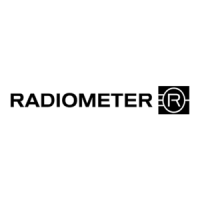ABL90 FLEX reference manual 5. Sensors and optical system
5-19
Element Potential Symbol
Reference electrode Known and constant when the
Ag/AgCl is immersed in the
electrolyte solution.
E
ref
Liquid junction between the
electrolyte solution in the
reference electrode and the
sample
Known and constant.
Independent of sample
composition.
E
LJ
Ion-sensitive membrane
separating the sample and
the pH sensor
Unknown. Dependent on sample
composition.
E
Sample
Solid-state contact Known and constant. E
E
Total potential Measured by the voltmeter. E
tot
The unknown potential difference across the ion-sensitive PVC membrane is the
difference between the measured total potential and the sum of the known
potentials:
ELJreftotalsample
EEEE=E
The potential difference across the membrane arises as a consequence of a
change in the charge balance at the membrane.
The membrane is sensitive to H
+
/electrolyte ions in that it has an ion exchange
ability. Since the internal solid-state reference electrode fixes the internal
potential, changes in the external charging of the membrane produce
measurable changes in the overall potential.
Having measured the unknown potential (E
sample
), the potential difference across
the membrane in the sensor can be expressed by the Nernst equation:
sample 0 x
R
EE ln
Fn
T
a
where:
E
0
= Standard electrode potential
R = Gas constant (8.3143 J/°K-mole)
T =
Absolute temperature (K)
n = Charge on the ion
F = Faraday constant (96487 C/mole)
x
a
= Activity of the species x
As shown in the equation above, measuring the potential of each of the
electrode chains gives a reading of the activity of the ions in the sample.
Activity expresses the "effective concentration" of a species and is explained in
more detail in the section
General measuring principles earlier in this section.
The activity of the ions is automatically converted to a concentration value by
the analyzer.
The relationship between activity and concentration is explained in the section
General measuring principles at the beginning of this chapter.
Unknown
potential
Ion-sensitive
membrane
Nernst
equation
Activity and
concentration

